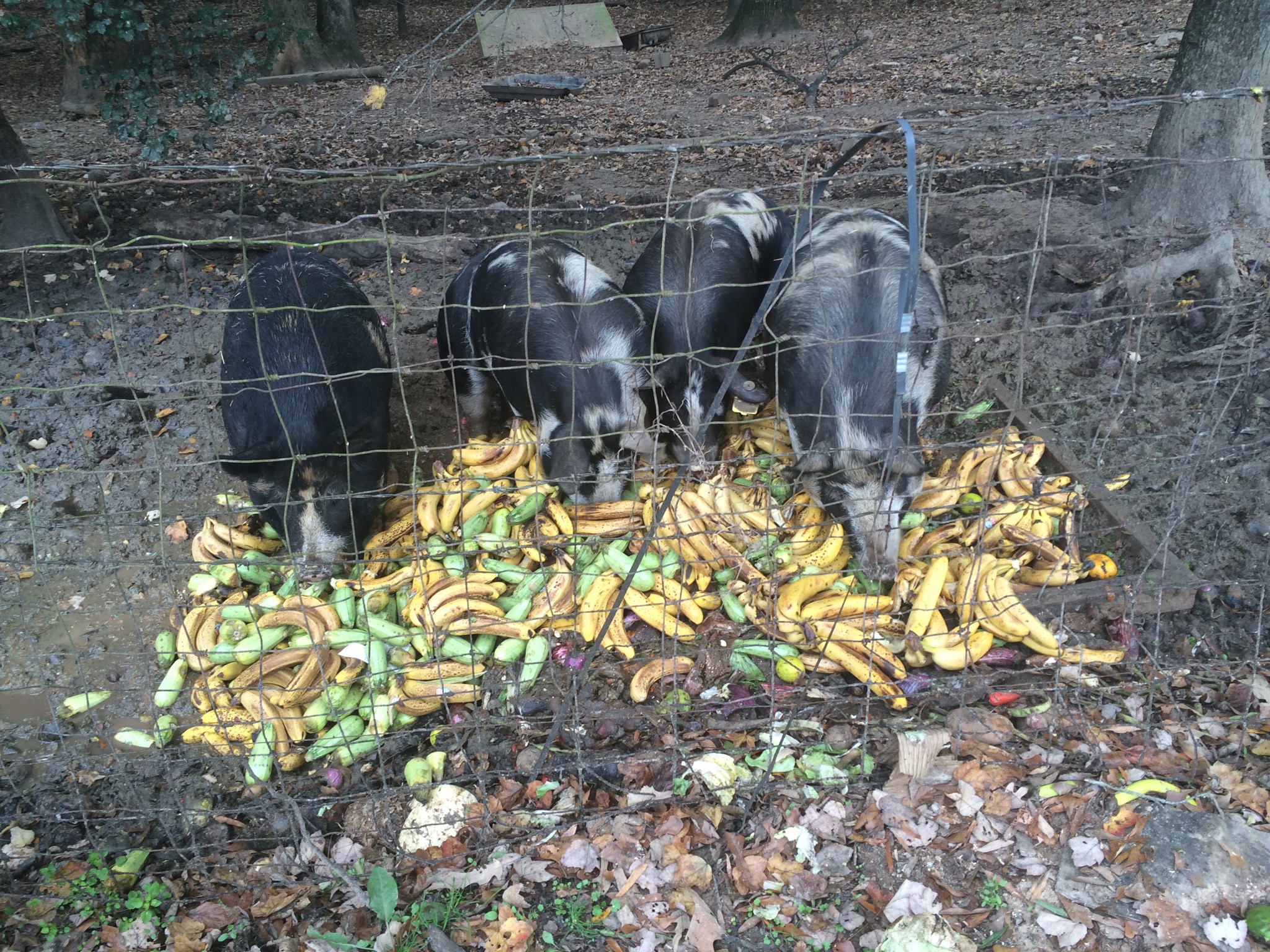Kids and cows. Too cute.
Feeding the bees

Last winter I was able to keep all three of my hives alive during the winter by feeding them honey as a supplement. I have tried sugar water and pollen patties with no success. Honey seemed to be the ticket. Go figure.
Today I fed the first of the honey to our bees, one large batch per hive. The honey is open fed, basically shoved into the back of the hive where the bees can get to it. I’m sure there is a better way, but not without buying some contraption I don’t want to buy. I had to cut out some comb to make room for the honey but the bees will rebuild it next spring.
I’m not sure why the bees sometimes don’t put enough honey away. We are going to put in a pollinator patch near our pond next year to help but I don’t think our bees suffer from lack of opportunities. Anyway, the honey is loaded and the bees are already putting it merrily away. The next batch will get loaded in December when we get a warm day.
Banana and zucchini smoothie
Benjamin has gotten sick, of course while I was out of town.
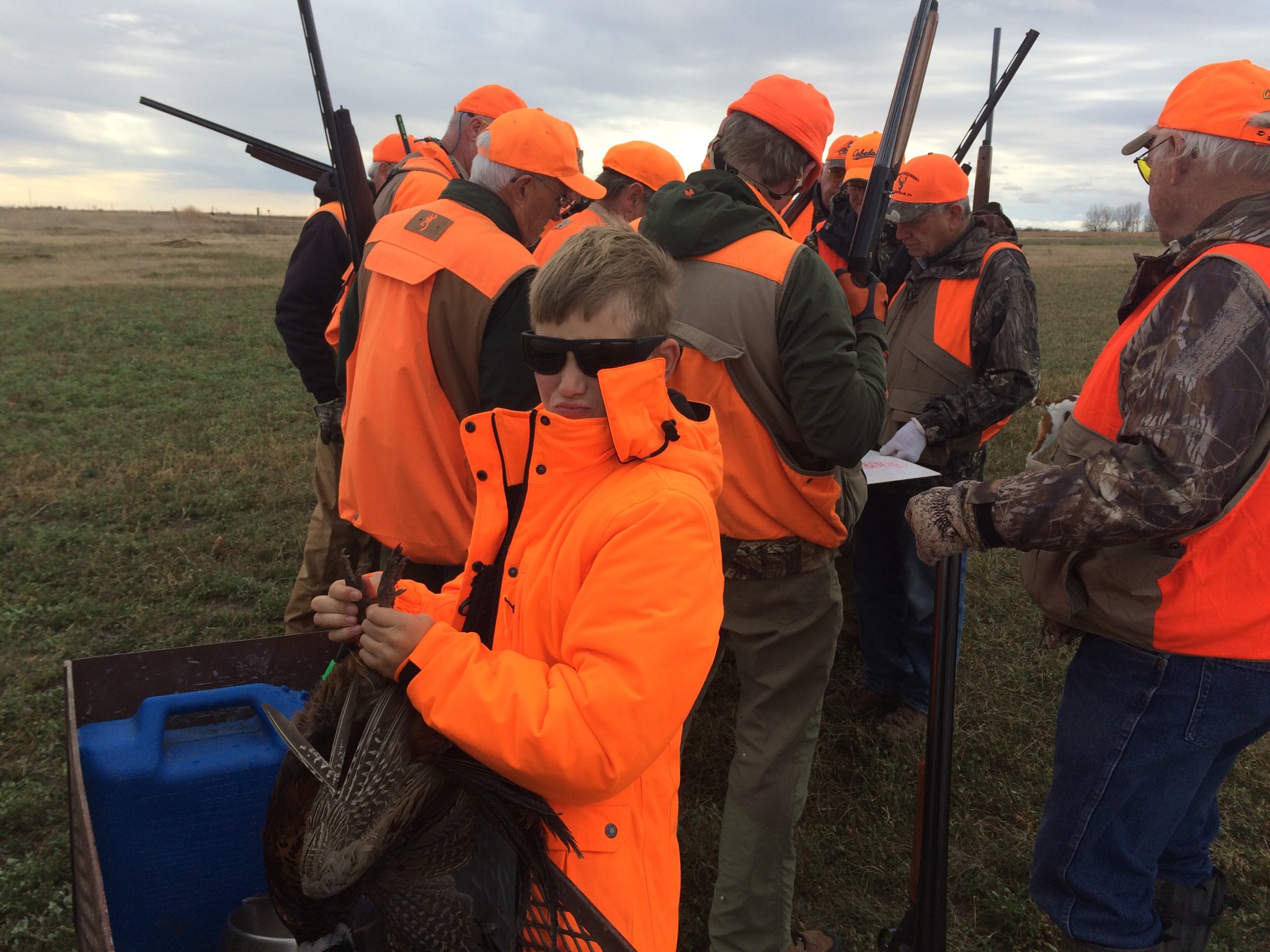
Last week Spork and I traveled to South Dakota to go pheasant hunting. It is our second time out there, and Spork was super excited. Anytime to spend time alone with his old man is a good time to him. Add in that it’s a lodge with 13 other men and no women in sight and it’s a testosterone fest. Since he is home with three women every day, any chance to do purely boy stuff is golden. Since I’m working so much of the time, any chance I have to take him is one I jump on. This year it wasn’t easy to get there but it was worth it.


The men were super impressed that Spork jumped with in on the processing table, helping gut birds. I didn’t dissuade them by telling them he helps gut cows, chickens, and pigs on the farm so this is old hat to him. Can something be old hat when you are only 10?
Of course, you can’t get off the farm without something going wrong. While I was gone, Miguel let me know that Benjamin was sick. Since I couldn’t do anything else, I told Miguel to call the vet and to put Benjamin into the head gate. I received the following picture later in the day.

Oh good. Looks like everything went fine. Later I received the following video.
Ok, still looks ok. He walked right in and was his usual calm self. The vet texted that Benjamin effectively had a cold and he’d treated him for that. Looks like all is well.
It’s only later that Miguel tells me that just after that video ends, Benjamin decided he didn’t like being in the head gate and nearly turned it over trying to get out. He said that he’d never seen anything like it. He said Ben’s neck is so big that the head gate couldn’t lock around it but since he is so big he could get out of the enclosure. Basically he was trapped in a box. Luckily everything held, barely, and Benjamin got some medicine for his cold. He is doing much better now so all’s well that ends well. Benjamin was treated on November 6th. He was given an injection of Banamine and Excede. He was treated by Dr. Maxwell from Summit Equine.

On the way home, while boarding a flight in O’Hare, the Captain grabbed Spork and offered him a tour of the cockpit. It was a flash back to the old days when kids used to get to do things like this. Spork thought it was pretty cool and as you can see, he was sporting his Ninja Cow Farm shirt. American Airlines is once again my favorite airline thanks to this very nice Captain.
The Captain did give me a quiz at the end. He gave me three chances to answer, “What makes an airplane fly?”
Do you know? I got it on the first try, but I’m a pilot so it’s cheating for me.
An interesting article on veganism, and how one of it’s proponents got it wrong
George Monbiot shares his correction on being vegan and why he was wrong.
Where do pumpkins go after Halloween?
 They go to Ninja Cow Farm. A few of our farmers unloaded on us their post Halloween pumpkins. What you see above is HALF of what we will be getting. Fortunately cows, pigs, and chickens all love pumpkins and pumpkins also keep very well. We will make full use of these pumpkins to give our animals a boost through the rest of this year.
They go to Ninja Cow Farm. A few of our farmers unloaded on us their post Halloween pumpkins. What you see above is HALF of what we will be getting. Fortunately cows, pigs, and chickens all love pumpkins and pumpkins also keep very well. We will make full use of these pumpkins to give our animals a boost through the rest of this year.
Snow at the farm?
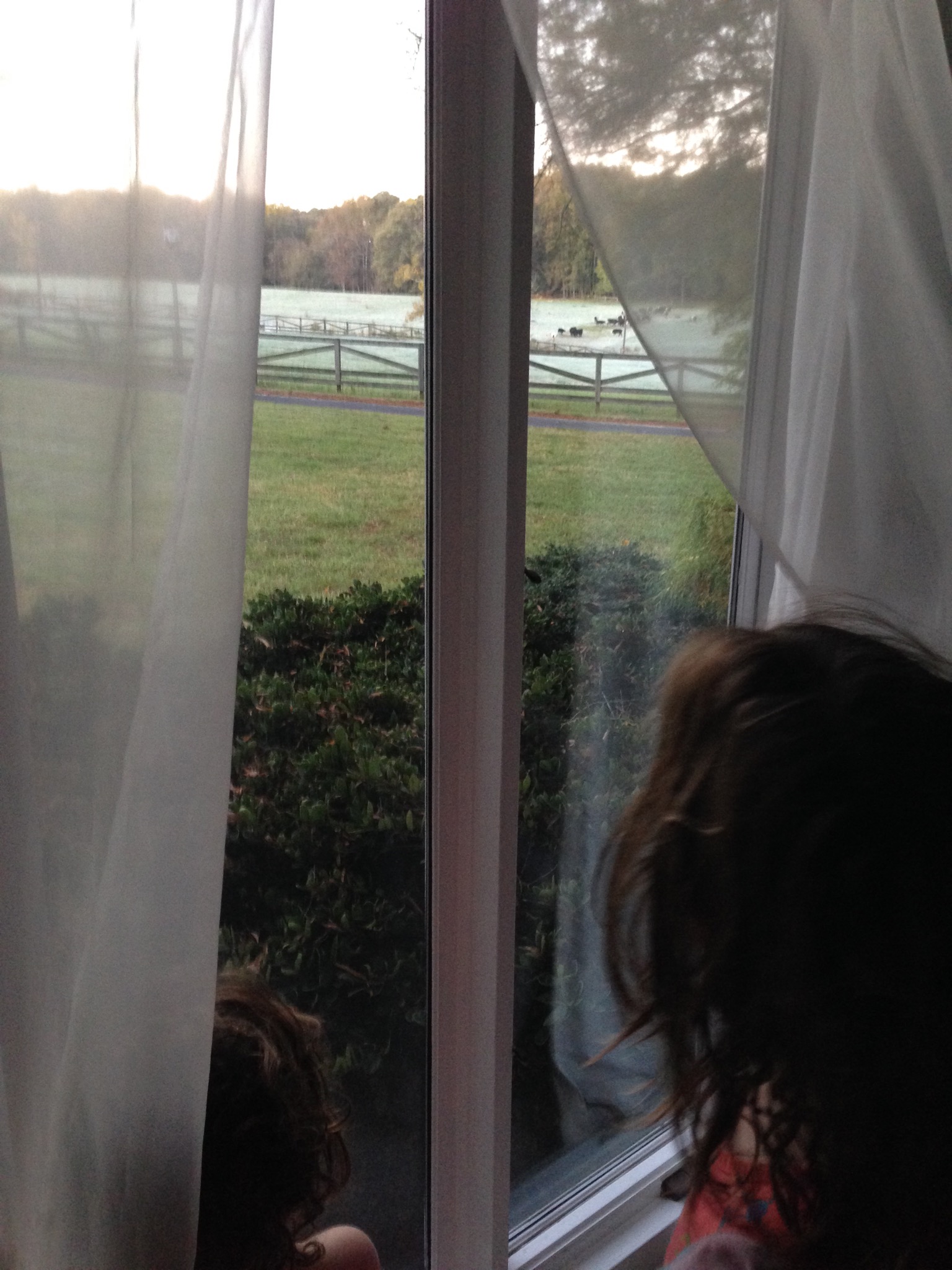
It’s more like a heavy frost but it didn’t stop the girls from geeking out. I’m excited for the girls, but I am not ready for winter.
First and foremost, growing grass and collecting produce are summer activities. And we have gotten pretty good at both. Although the work is hard, the bounty of food that flows from April to October allows us to have more food than we need every day for all of our animals. Knowing you can feed everyone all the time takes a huge weight off of a farmers shoulders. We don’t have a silo of corn to feed from should we run short. We have to produce food through our efforts and our farmers every day.
With the grass, we have a better and better product every time I look. Last year I was amazed and excited that we had built 3/4″ of topsoil in addition to our wildly improved grass. We were still suffering through weeds we didn’t want in the pasture but things were improving. This year we have built at least another 3/4″ of topsoil and our mowing program has made the weeds almost a non-event. The grass this year has been phenomenal, all the while allowing our stocking density to increase to levels we could not sustain with traditional methods.
When I learned about our grazing techniques, I was dismayed to learn that you shouldn’t expect truly representative results until the third year of the program. Next summer will be our third year. I can’t imagine things getting any better.
Normally this is the time we like to slow down, put the cows out for hay instead of grazing, and get into the shop to get some projects done.
However this year I am still wearing short sleeves, and I am so busy at work I don’t have time for my normal winter fun activities. Maybe by Thanksgiving things will settle down and I will be in a winter mood, but for now I’m looking at those white pastures with trepidation and longing for summer days.
Hay arrives for winter feeding


We picked up two loads of hay this past week. Each load is 17 bales so we have 34 bales on the farm now. 17 are staged in the winter feeding pasture, the other 17 are stacked in the barn yard. We’ll pick up at least another 34 bales, probably more. It depends on how cold the winter is, and how the cows need to be taken care of over the winter. Hopefully this winter won’t be too cold and we won’t need too much hay. It’s over $1000 for the 34 bales so it’s no small investment each time we haul hay.
New grazing measurement program in conjunction with NRCS
This year we have started a new program in concert with NRCS to measure our pasture management. We were given a choice of many programs we could adopt, but this pasture management one fit what we do very well and really was a best practice we should have been doing anyway.

What we have done is to place permanent measurement markers in three different pastures on our farm. The markers have inch graduations from the ground on up to a couple of feet. Before we put our cows into a paddock for the day, we measure the grass by taking picture like the ones below.

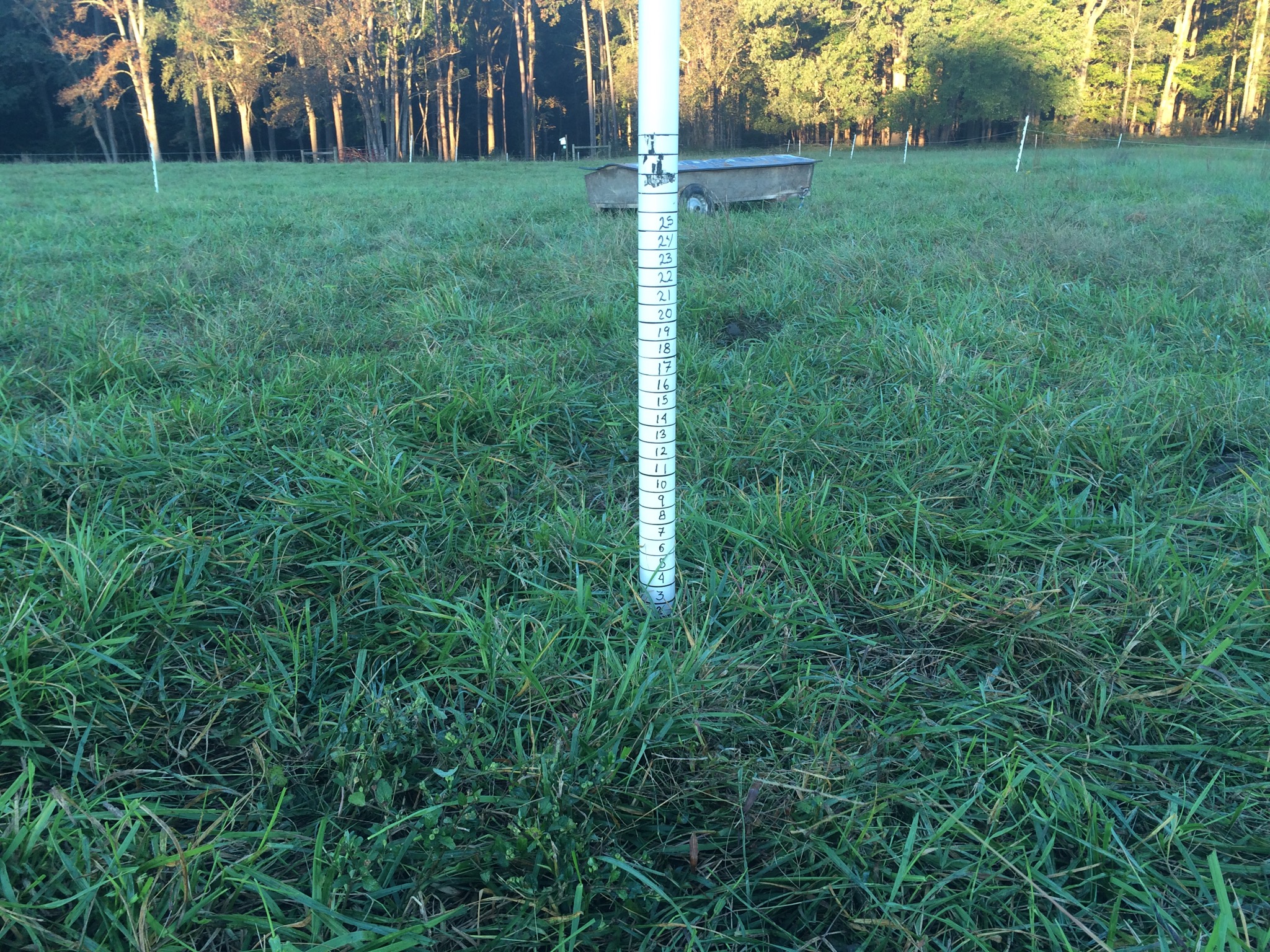
This is field #2, which is the one closest to the golf course. As you can see pre-grazing, the grass is about 9-10″ high and the tips are around 16″.This is post grazing. You may have to zoom in a bit to see that the grass is now 4-5″ tall. We have grazed this grass heavier than normal because the cows won’t make it back around to this pasture before it’s time to go onto hay for the winter. We still left plenty of grass for ground cover.
This grazing took place on Thursday, October 23rd, 2014.
It’s actually making me kind of sad to see the last of the grass in the before pictures. We have had a tremendous increase in grass production in our second year of daily paddock moves. The topsoil creation has been very good. I haven’t actually measured it, but we have to be over a few inches based on the one spot I looked. You have to compare that against the 1/8″ or less of topsoil we had when we started this program. I was told that when we started this program, we really shouldn’t except much till about the third year. So far we’ve had wonderful results and that makes me really look forward to next year to see what these “real results” will look like. The grass could be thicker, the weeds could be less. Things can continue to improve, but it’s come so far so fast it’s hard to imagine it getting a lot better. One thing I haven’t done in a while is to test soil PH. I’m looking forward to testing it next year and then comparing it against where we were when we started. I was talking with Themis from NRCS this week and she was saying what I understood to be the case. By building so much organic material on the surface, we should see the soil PH come up from 5.1-5.3 to more in the 7.0 range which would be perfect. Even if we are making progress, maybe in the high 5s, it’s an indication that what we are doing is working and we can continue forward with our current practices, knowing we will get where we are going in the future.
Benjamin takes a mud bath
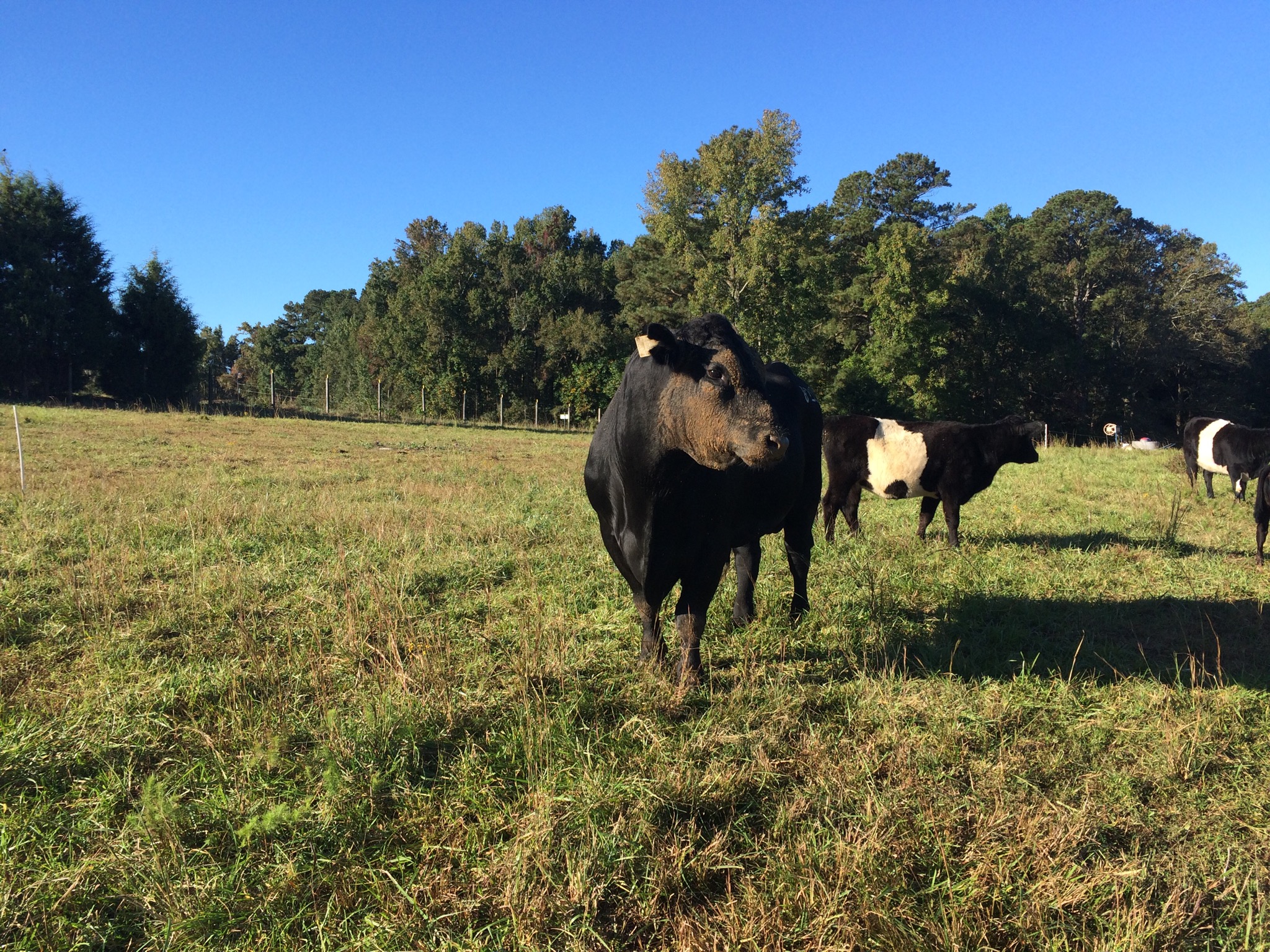
Benjamin must be having trouble with the ladies because he decided to get a mud facial this morning. We have some exposed dirt where we trenched a water line to the pigs earlier this year. I don’t know what it is about cows and dirt but they love to rub it all over their face, especially bulls. Benjamin is no exception.

The cows are eating marvelous grass now, but it’s the last graze of the season. Next week I will be going to get the first loads of hay and in a few weeks that’s all we will have for them to eat besides what comes from the market. The cows look wonderful and this years grazing has put the pounds on them. We will be taking 4 to be processed in about a month taking our winter stock down to 27. That’s a few more than last winter but I may end up selling another cow or two along the way. Fortunately our numbers have come up enough to cull effectively now so we can continue to enhance our bloodlines. Benjamin’s calves are noticeably bigger than our normal calves at the same age. Having his genetics in the herd is going to be a good thing.
